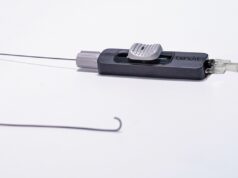
A transmural approach for accessing the perivascular tissues of the cervical carotid artery has been deemed safe following initial evaluations in a swine model.
Geoffrey Colby, Wi Jin Kim and Milan Samarage (all University of California Los Angeles [UCLA], Los Angeles, USA), and colleagues, have published findings from their safety assessment in the Journal of NeuroInterventional Surgery (JNIS)—concluding that this endovascular technique “represents a novel approach to various tissues in close proximity to the cervical and cranial vasculature”.
“Recent advances in endovascular devices have allowed access and targeting of perivascular tissues of the peripheral circulation,” the authors state, outlining the backdrop to their research. “The perivascular tissues of the cervical and cranial circulations have many important structures of clinical significance, yet the feasibility and safety of such an approach has not been demonstrated.”
As such, they set out to evaluate the safety of a novel endovascular transmural approach to target the perivascular tissues of the common carotid artery in swine.
Initially, a micro-infusion device was positioned in the carotid arteries of three Yorkshire swine—across a total of six carotid arteries—with each carotid artery being punctured 10 times in the same location to gain access to the perivascular tissues.
Digital subtraction angiography was used to evaluate vessel injury or contrast extravasation, while magnetic resonance imaging (MRI) and MR angiography were used to evaluate evidence of cerebral ischaemia or vessel injury. Writing in JNIS, the authors further note that post-mortem tissue analysis was performed to assess for extravascular haematoma and intravascular dissection.
“None of the tested carotid arteries showed evidence of vessel injury (dissection or perforation) or intravascular thrombosis,” they state, reporting the results of their study. “MRI performed after repeated puncture was negative for neck haematoma and brain ischaemia. Post-mortem tissue analysis of the carotid arteries showed mild adventitial staining with blood, but without associated haematoma and without vessel dissection.”
This led the researchers to conclude that the endovascular transmural approach they assessed appears to be safe as a novel way of accessing the carotid artery perivascular tissues.
“The novel endovascular transmural approach represents a means of targeting cervical and cranial perivascular tissues that was not previously possible,” Colby stated, speaking to NeuroNews. “This opens a new realm for minimally invasive delivery of therapeutics for inhibition, activation, or modulation, of numerous important anatomical structures, such as components of the autonomic nervous system. Future clinical applications are broad, but early use may involve conditions with hyperactivity of the sympathetic nervous system, such as cerebral vasospasm that occurs after rupture of a brain aneurysm or traumatic brain injury.”









